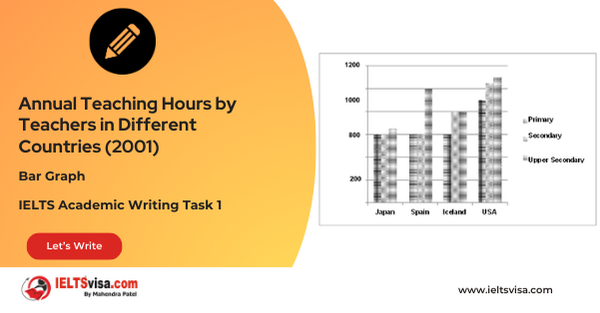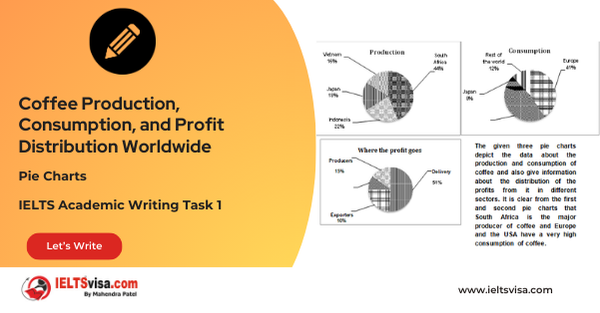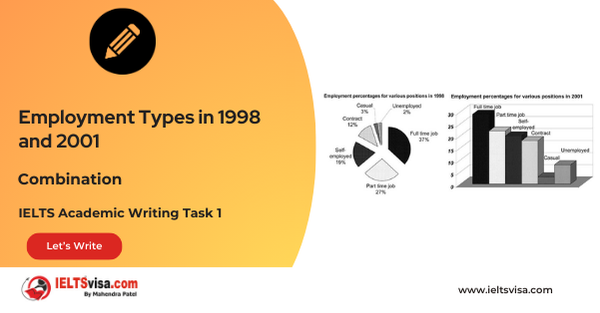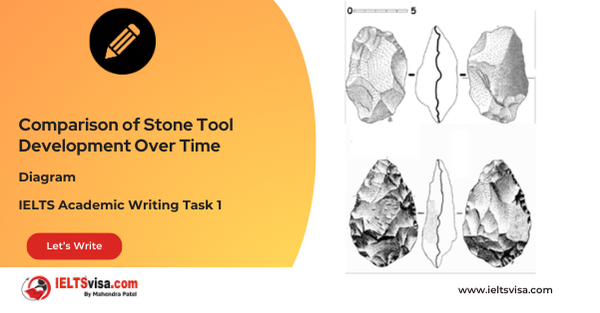Top Grades Achieved by Male and Female Students (1960 and 2000)
IELTS Academic Writing Task 1 - Combination Bar Graph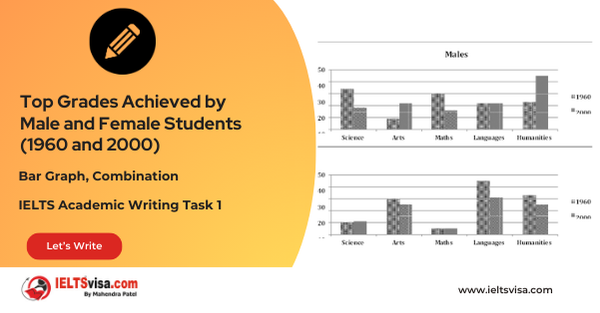
IELTS Writing Task 1 Question
The charts below show the percentages of male and female students getting top grades in 1960 and 2000. Summarise the information by selecting and reporting the main features and make comparisons where relevant.
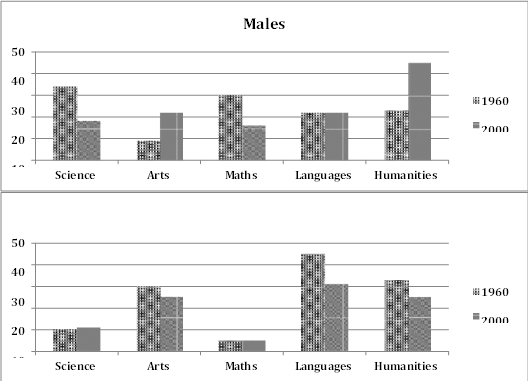
Common Questions for the Combination Bar Graph
1. Graph Type: Column Graph
2. Title: Top Grades Achieved by Male and Female Students (1960 and 2000)
3. Units of Measurement: Percentage of students achieving top grades
4. Who: Male and female students
5. When: 1960 and 2000
6. Where: Not specified, but generally applicable to a school or educational context
7. Topic: Comparison of male and female students achieving top grades in five subjects
Comparison Showing and Trends Any change over time (such as an increase or a decrease) is a trend.
Comparison 1: Male Students in 1960 and 2000
- Details:
1. In 1960, slightly over 30% of boys achieved top grades in science and math, while only 10% excelled in arts.
2. By 2000, the percentage of boys scoring top grades in arts and humanities nearly doubled, yet science and math scores halved.
Comparison 2: Female Students in 1960 and 2000
-
Details:
1. In 1960, girls performed exceptionally well in languages (45%), arts (32%), and humanities (30%), but only 10% scored high in science and 5% in math.
2. In 2000, the percentages of girls achieving top grades in arts, languages, and humanities saw a moderate decline, while their performance in science and math remained stable.
Sample Answer
The column graphs illustrate the percentages of male and female students achieving top grades in five subjects—science, arts, maths, languages, and humanities—in the years 1960 and 2000.
Overall, girls consistently excelled in arts and languages, while boys performed better in science and maths.
In 1960, slightly over 30% of boys scored top grades in science and maths, whereas only 10% excelled in arts. In contrast, girls achieved higher scores in languages (45%), arts (32%), and humanities (30%), with only 10% scoring high in science and just 5% in maths.
By 2000, the performance of boys in arts and humanities had almost doubled, but their scores in science and maths had decreased to around 15%. The percentage of top scorers in languages remained unchanged. Girls, however, experienced a moderate decline in top grades in arts, languages, and humanities, while their scores in science and maths held steady. Notably, it is surprising that boys outperformed girls in humanities by 2000, indicating a shift in academic trends over the decades.
Top 28 Vocabularies
| Vocabulary (type) | Type | Meaning | Synonyms | Examples |
| Proportion | Noun | A part or share of a whole | Percentage, fraction, ratio | “The proportion of boys scoring high in science was slightly over 30%.” |
| Excel | Verb | To perform exceptionally well | Succeed, shine, thrive | “Girls excelled in languages and arts.” |
| Achieve | Verb | To successfully reach a desired objective | Attain, accomplish, realize | “Students achieved top grades in various subjects.” |
| Moderate | Adverb | Average in amount, intensity, or degree | Average, reasonable, mild | “There was a moderate decline in girls’ top grades.” |
| Shift | Noun | A change or movement | Change, transition, alteration | “A shift in academic trends occurred over the decades.” |
| Illustrate | Verb | To show or explain using examples or visuals | Demonstrate, depict, portray | “The graphs illustrate the percentages of top scorers.” |
| Consistently | Adverb | In a steady and reliable manner | Regularly, uniformly, steadily | “Girls consistently excelled in arts and languages.” |
| Performance | Noun | The act of accomplishing a task | Achievement, result, execution | “Boys’ performance in arts improved over the decades.” |
| Decline | Verb | To decrease in quality, quantity, or importance | Decrease, reduce, drop | “Girls experienced a decline in top grades in humanities.” |
| Notable | Adjective | Worthy of attention | Remarkable, significant, outstanding | “It is notable that boys outperformed girls in humanities by 2000.” |
| Gender | Noun | The classification of male or female | Sex, category, group | “Gender differences in academic performance are evident.” |
| Academic | Adjective | Related to education or studies | Scholarly, educational | “The data highlight academic trends over time.” |
| Transition | Noun | A process of change from one state to another | Shift, change, progression | “The transition in boys’ performance in arts is remarkable.” |
| Outperform | Verb | To perform better than | Surpass, excel, exceed | “Boys outperformed girls in humanities by 2000.” |
| Decades | Noun | Periods of ten years | Eras, time spans | “The passage compares performance trends across decades.” |
| Steady | Adjective | Stable or unchanging | Constant, consistent, fixed | “Girls’ performance in science and maths remained steady.” |
| Compare | Verb | To examine similarities and differences | Contrast, evaluate, assess | “The graphs compare male and female performance across subjects.” |
| Subject | Noun | An area of study | Discipline, topic, field | “Science and maths were the strongest subjects for boys.” |
| Variation | Noun | A change or difference | Fluctuation, difference, diversity | “There was significant variation in performance across subjects.” |
| Prominent | Adjective | Important or well-known | Noticeable, distinguished, leading | “Girls had a prominent lead in language scores.” |
| Represent | Verb | To stand for or symbolize | Portray, signify, embody | “The data represent shifts in educational performance trends.” |
| Slightly | Adverb | To a small degree | Marginally, somewhat, mildly | “Boys’ performance in arts improved slightly over the decades.” |
| Hold steady | Verb | To remain unchanged | Stay constant, maintain, persist | “Girls’ scores in science and maths held steady.” |
| Academic trends | Noun | Patterns in educational performance or behavior | Educational patterns, study trends | “Academic trends shifted significantly over time.” |
| Surprising | Adjective | Unexpected or unusual | Shocking, astonishing, remarkable | “It is surprising that boys outperformed girls in humanities.” |
| Percentage | Noun | A portion of a whole expressed in hundredths | Proportion, fraction, part | “The percentage of top-scoring boys in science dropped by 2000.” |
| Achievement | Noun | Something accomplished through effort | Accomplishment, success, attainment | “The achievement of top grades was notable in certain subjects.” |
| Evident | Adjective | Clearly visible or understood | Apparent, clear, obvious | “Gender-based performance differences were evident.” |

Our Books
Master IELTS Speaking Part 1
IELTS Writing Task 1 Book
IELTS Writing Task 2 Book
Practice IELTS Other Modules
IELTS Listening
The IELTS Listening test assesses how well you can understand spoken English in various contexts. It lasts about 30 minutes and is divided into four sections with a total of 40 questions. The listening tasks become increasingly difficult as the test progresses.
IELTS Academic Reading
The IELTS Academic Reading section assesses your ability to understand and interpret a variety of texts in academic settings. It is designed to evaluate a range of reading skills, including skimming for gist, reading for main ideas, reading for detail, understanding inferences, and recognizing a writer's opinions and arguments.
IELTS Speaking
The IELTS Speaking test assesses your ability to communicate in English on everyday topics. It lasts 11-14 minutes and consists of three parts: introduction, cue card, and a discussion based on the cue card topic.
IELTS General Reading
IELTS General Reading tests your ability to understand and interpret various types of texts. Here are some key areas and types of content you can expect to encounter in the reading section, along with tips for effective preparation.
IELTS Academic Writing Task 1
In IELTS Academic Writing Task 1, you are presented with a visual representation of information, such as graphs, charts, tables, or diagrams, and you are required to summarize, compare, or explain the data in your own words.
IELTS General Writing Task 1
In IELTS General Writing Task 1, you are required to write a letter based on a given situation. The letter can be formal, semi-formal, or informal, depending on the prompt. Here’s a breakdown of the key components to include in your letter
IELTS Academic Writing Task 2
In IELTS Academic Writing Task 2, you are required to write an essay in response to a question or topic. Here’s a guide to help you understand the essential elements of this task
IELTS Exam Tips
To succeed in the IELTS exam, practice regularly, familiarize yourself with the test format, improve your vocabulary, develop time management skills, and take mock tests to build confidence.
Grammer for IELTS
Grammar is the foundation of effective communication in English. Understanding tense usage, subject-verb agreement, and sentence structure enhances clarity and coherence in writing and speaking.
Vocabulary for IELTS
Vocabulary plays a crucial role in the IELTS (International English Language Testing System) exam, especially in the Speaking and Writing sections. Here’s an overview of why vocabulary is important and how it impacts your performance
RECENT IELTS SAMPLES QUESTIONS AND ANSWERS
Task 1 – Column graph – Percentage of Young People Enrolled in Universities in 2000 and 2007.
20:00 Start Pause Stop [df_adh_heading title_infix="IELTS Writing Task 1 Question" use_divider="on"...
Task 1 – Bar Graph – Annual Teaching Hours by Teachers in Different Countries (2001)
20:00 Start Pause Stop [df_adh_heading title_infix="IELTS Writing Task 1 Question" use_divider="on"...
Task 1 – Pie Charts – Coffee Production, Consumption, and Profit Distribution Worldwide
20:00 Start Pause Stop [df_adh_heading title_infix="IELTS Writing Task 1 Question" use_divider="on"...
Task 1 – Column graph – Types of Transport Used by Tourists Visiting New Zealand from Five Countries in 2004.
20:00 Start Pause Stop [df_adh_heading title_infix="IELTS Writing Task 1 Question" use_divider="on"...
Task 1 – Bar and Pie Chart Combination – Employment Types in 1998 and 2001
20:00 Start Pause Stop [df_adh_heading title_infix="IELTS Writing Task 1 Question" use_divider="on"...
Task 1 – Diagram – Comparison of Stone Tool Development Over Time
20:00 Start Pause Stop [df_adh_heading title_infix="IELTS Writing Task 1 Question" use_divider="on"...


